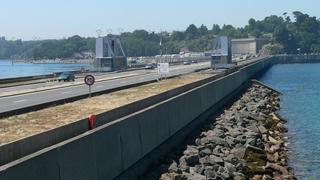Tidal Energy
Updated on 12.22.20225 min read
Tidal energy is based on the surge of enormous amounts of water as ocean tides rise and fall. This energy is generally recovered through a dam built across an estuary.

© Wikicommons - The dam at the Rance tidal power plant in Brittany, France is 750 meters long.
Underexploited Potential
The worldwide potential of tidal is underexploited at present. With a current of just over 500 MW, it could in fact provide up to 380 TWh per year with a capacity of 160 GW. This potential remains, however, far below that of land-based hydropower, since worldwide hydroelectricity production from conventional dams stood at over 3,600 TWh in 2012.
The idea behind plants is simple. A dam built across a river estuary lets seawater through twice a day, at high tide and low tide, driving turbines that produce electricity using a generator. At low tide, the dam can also be closed to hold back river water, which is then used in the same way as in a conventional hydroelectric dam. The must be over 5 meters, and ideally between 10 and 15 meters, to ensure profitable operations.
Tidal Power: Advantages and Disadvantages
Like other marine energy sources, tidal energy has the advantage of being a that, once the dam has been built, produces no greenhouse gas emissions. However, power generation is intermittent. There are (predictable) periods when there is not enough current or retained water for the turbines to operate. It has a significant , altering balances upstream and downstream of the dam. In addition, investment and maintenance costs are very high.
Plants Worldwide
France pioneered tidal energy in 1966 with the commissioning of the La Rance1 tidal power plant near St. Malo. The area around the plant is known for having some of the highest tides in the world. In the 12th century, watermills were built to capture energy from the tides. Set up 750 meters off the coast on the Rance estuary, the plant's 24 turbines have an installed capacity of 240 MW and operate during both high and low tides. Annual output is 540 GWh, equivalent to the energy use of a city with a population of 300,000.
For a long time it was the biggest such plant in the world, but was overtaken in August 2011 by the Sihwa tidal power plant in Gyeonggi Bay, South Korea. It has an installed capacity of 254 MW, just ahead of the La Rance plant (240 MW).
Ongoing Projects
Many highly ambitious projects were announced in the early 2010s and included new designs, one of which was the “tidal lagoon”. It works in a similar way to an artificial lake, by filling up with water at high tide and then releasing the water through airlocks equipped with turbines. The system is said to be safer for the environment.
The United Kingdom had considered building this type of facility in Swansea Bay, Wales, but the government abandoned the project in 2018. Canada, Russia and India also made announcements but with no immediate outcomes.
After large tidal barrages and lagoons, the current trend is to explore a third method for capturing tidal energy – tidal stream generators, such as those that capture sea or river currents. The objective here is to install as many as possible at locations where the tides move huge volumes of water.
The United Kingdom has kicked off the Meygen project2 in the Pentland Firth at the Northeast point of Scotland, which is moving forward in stages: with 28 MW in 2022, it is aiming to achieve 86 MW with 50 turbines in phase 1. In theory, the site could reach 400 MW.
Sources:
- See detailed information The Rance tidal power plant - EDF (French only)
- See Meygen project details







